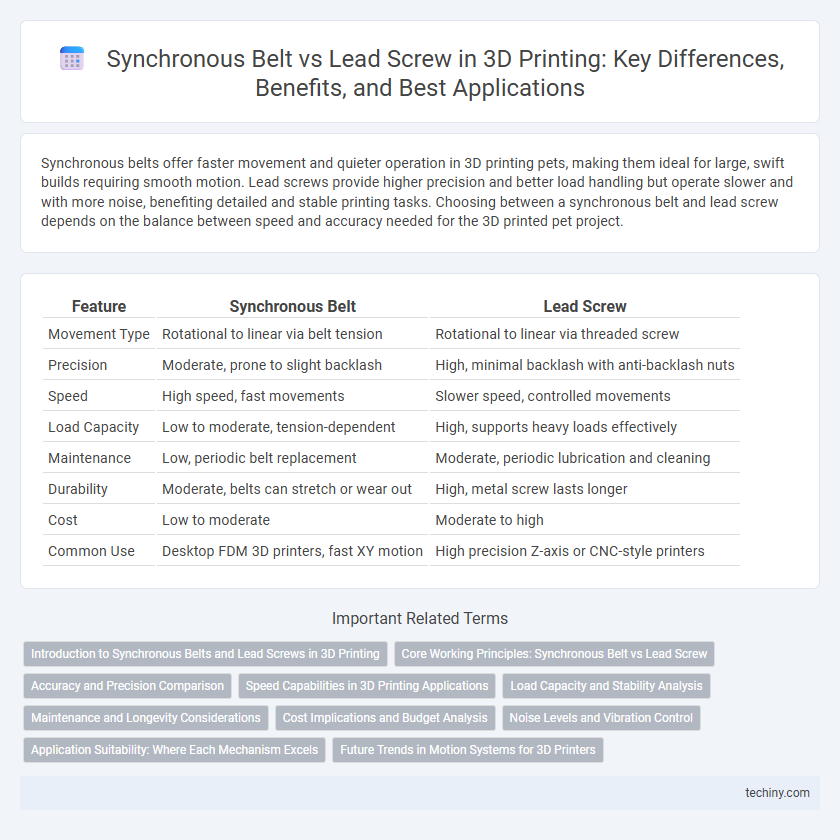Synchronous belts offer faster movement and quieter operation in 3D printing pets, making them ideal for large, swift builds requiring smooth motion. Lead screws provide higher precision and better load handling but operate slower and with more noise, benefiting detailed and stable printing tasks. Choosing between a synchronous belt and lead screw depends on the balance between speed and accuracy needed for the 3D printed pet project.
Table of Comparison
| Feature | Synchronous Belt | Lead Screw |
|---|---|---|
| Movement Type | Rotational to linear via belt tension | Rotational to linear via threaded screw |
| Precision | Moderate, prone to slight backlash | High, minimal backlash with anti-backlash nuts |
| Speed | High speed, fast movements | Slower speed, controlled movements |
| Load Capacity | Low to moderate, tension-dependent | High, supports heavy loads effectively |
| Maintenance | Low, periodic belt replacement | Moderate, periodic lubrication and cleaning |
| Durability | Moderate, belts can stretch or wear out | High, metal screw lasts longer |
| Cost | Low to moderate | Moderate to high |
| Common Use | Desktop FDM 3D printers, fast XY motion | High precision Z-axis or CNC-style printers |
Introduction to Synchronous Belts and Lead Screws in 3D Printing
Synchronous belts and lead screws are essential motion components in 3D printing, providing precise control of the printhead or build platform movement. Synchronous belts offer high-speed linear motion with low backlash and are commonly used in Cartesian 3D printers for smooth, quiet operation. Lead screws deliver superior positional accuracy and torque, making them ideal for applications requiring greater mechanical stability and load-bearing capacity in 3D printing setups.
Core Working Principles: Synchronous Belt vs Lead Screw
Synchronous belts operate using toothed belts and pulleys to transfer motion with precise timing, enabling fast and smooth linear movement in 3D printers. Lead screws convert rotary motion into linear motion via a threaded shaft and nut mechanism, offering high positional accuracy and strong load-holding capabilities. Core differences lie in speed and precision: belts provide higher velocity with potential backlash, while lead screws deliver superior repeatability and force control but at slower speeds.
Accuracy and Precision Comparison
Synchronous belts offer moderate precision with smoother motion and faster speeds, making them suitable for 3D printers requiring quick repositioning but slightly less accuracy. Lead screws provide superior accuracy and repeatability due to their rigid, low-backlash design, ideal for high-resolution 3D printing where precise layer alignment is critical. The choice between synchronous belts and lead screws directly impacts print quality, with lead screws favored for applications demanding tighter tolerances and finer detail.
Speed Capabilities in 3D Printing Applications
Synchronous belts offer higher speed capabilities in 3D printing due to their lightweight design and low inertia, enabling rapid movement and faster print times. Lead screws provide precise motion but are generally slower because of higher friction and mechanical resistance, which can limit acceleration and top speed. For applications prioritizing fast layer deposition, synchronous belts are often preferred, while lead screws suit projects demanding high positional accuracy over speed.
Load Capacity and Stability Analysis
Synchronous belts provide high-speed motion with moderate load capacity, offering smoother operation and reduced backlash, which enhances print quality in 3D printers. Lead screws excel in handling higher loads and delivering precise linear motion with excellent stability, making them ideal for applications requiring robust positional accuracy. Load capacity of lead screws generally surpasses that of synchronous belts, but belts offer better dynamic responsiveness for rapid, less load-intensive movements.
Maintenance and Longevity Considerations
Synchronous belts require regular tension adjustments and inspections to prevent stretching and wear, which can lead to slippage and print inaccuracies, while lead screws demand periodic lubrication and cleaning to avoid buildup and corrosion that impair smooth motion. Belts generally have a shorter lifespan but offer quieter operation and easier replacement, whereas lead screws provide higher durability and precision over time, especially in environments with consistent maintenance. Choosing between the two depends on balancing the time allocated for upkeep against the desired level of accuracy and machine longevity.
Cost Implications and Budget Analysis
Synchronous belts generally offer a lower initial cost and simpler maintenance compared to lead screws, making them ideal for budget-conscious 3D printer builds. Lead screws, while more expensive upfront, provide higher precision and durability, which can reduce long-term replacement and calibration costs. Evaluating total cost of ownership, including parts, maintenance, and potential downtime, is crucial for optimizing budget allocation in 3D printer design.
Noise Levels and Vibration Control
Synchronous belts in 3D printers provide quieter operation with reduced noise levels compared to lead screws, making them ideal for environments requiring minimal sound disruption. Lead screws tend to produce higher mechanical noise and vibrations due to their threaded design, which can affect print quality by introducing slight inconsistencies during motion. Effective vibration control in synchronous belt systems leads to smoother movements and improved precision, enhancing overall 3D printing performance.
Application Suitability: Where Each Mechanism Excels
Synchronous belts excel in high-speed 3D printing applications requiring rapid and smooth motion with low inertia, making them ideal for moving gantries and lightweight printer axes. Lead screws provide superior precision and higher load capacity, which suits applications demanding accuracy and consistent force, such as Z-axis movement or printers with heavy build platforms. Choosing between the two depends on the balance between speed, accuracy, and load requirements unique to each 3D printer design.
Future Trends in Motion Systems for 3D Printers
Synchronous belts dominate current 3D printer motion systems due to their high speed and cost-effectiveness, but lead screws are gaining traction for applications demanding greater precision and load capacity. Emerging trends highlight hybrid systems combining belt speed with lead screw accuracy, fueled by advancements in materials and control algorithms. Future 3D printers will likely feature adaptive motion solutions optimizing stiffness, noise reduction, and energy efficiency, driven by ongoing innovation in actuator technology.
Synchronous belt vs Lead screw Infographic

 techiny.com
techiny.com